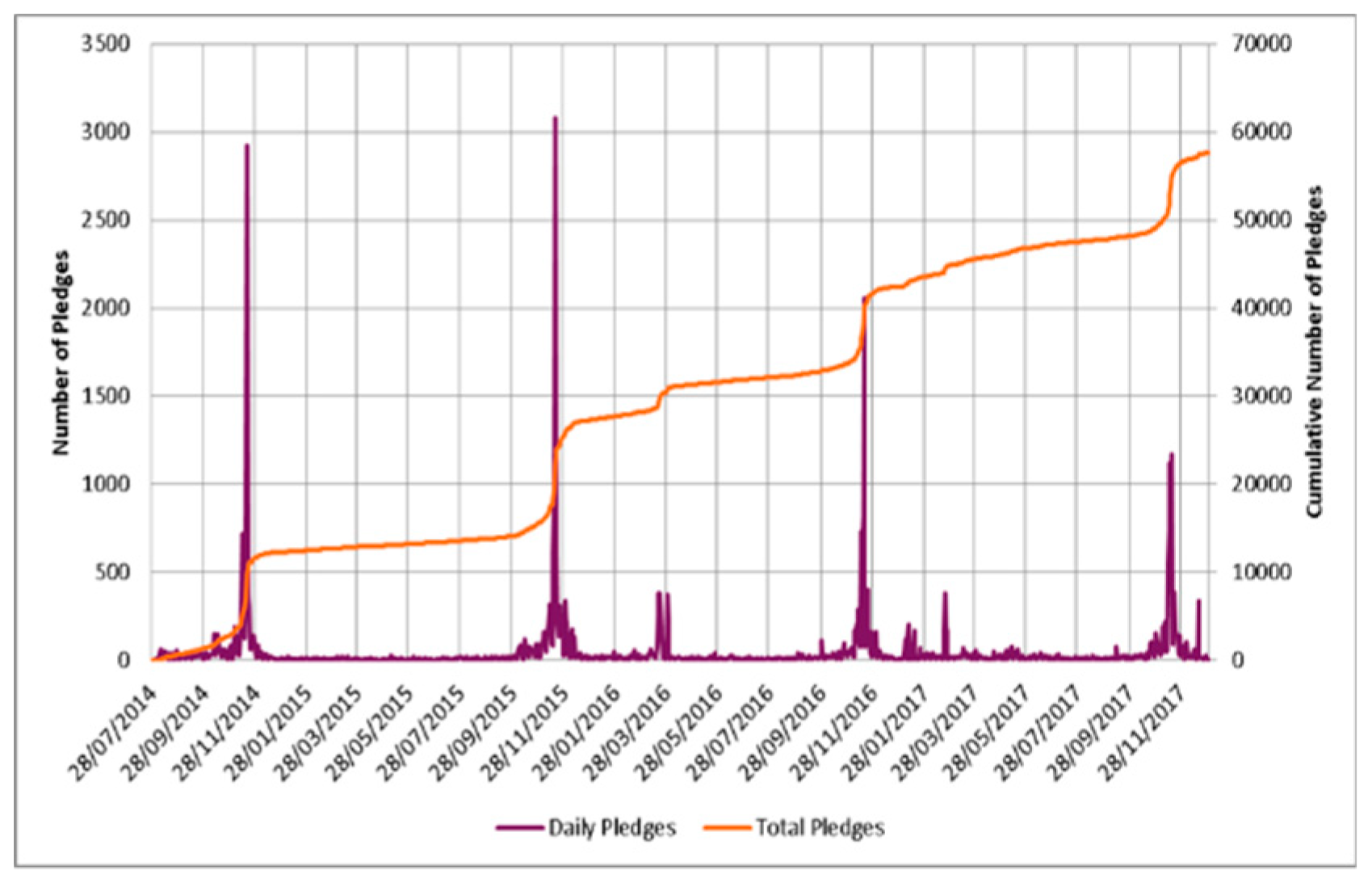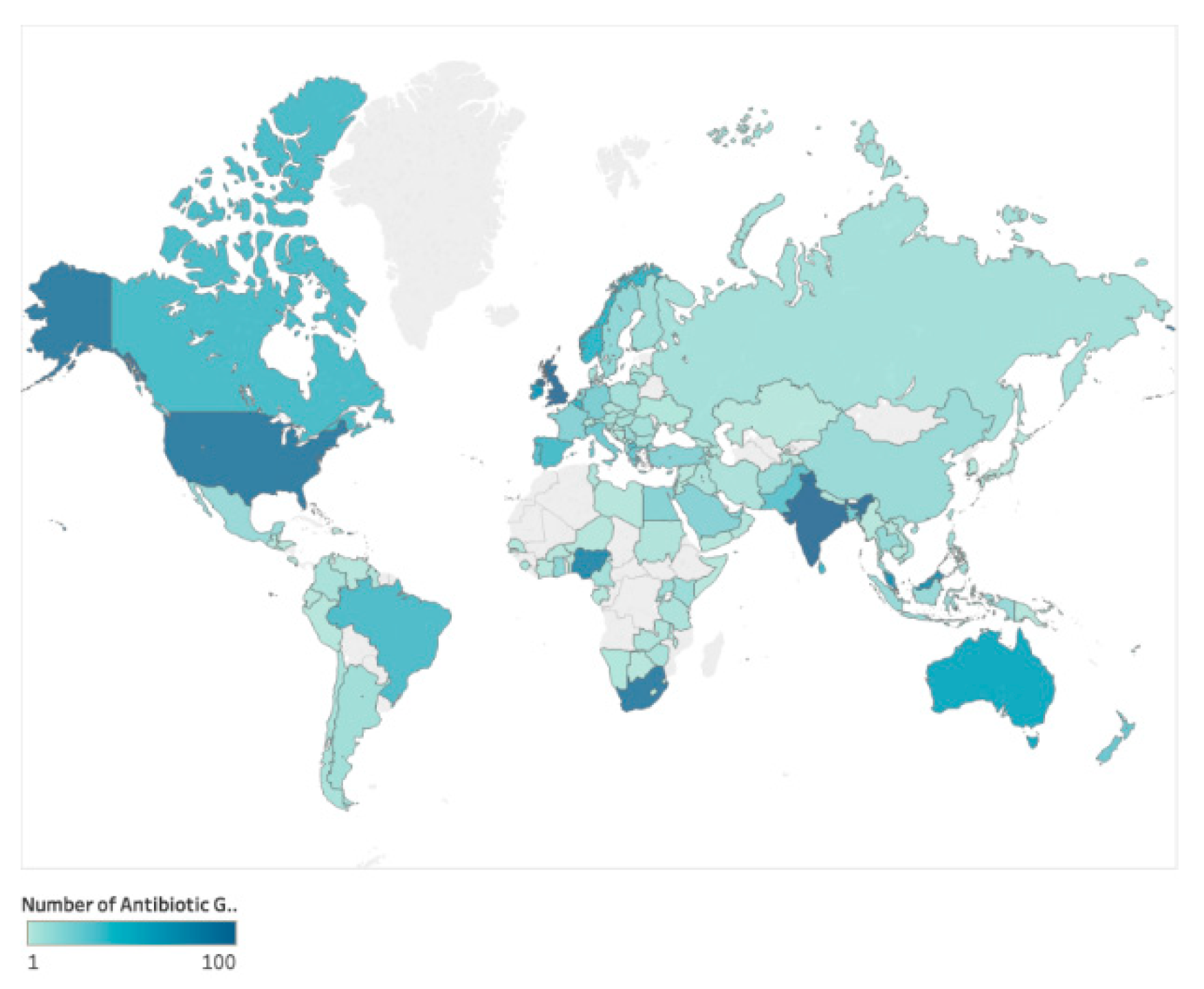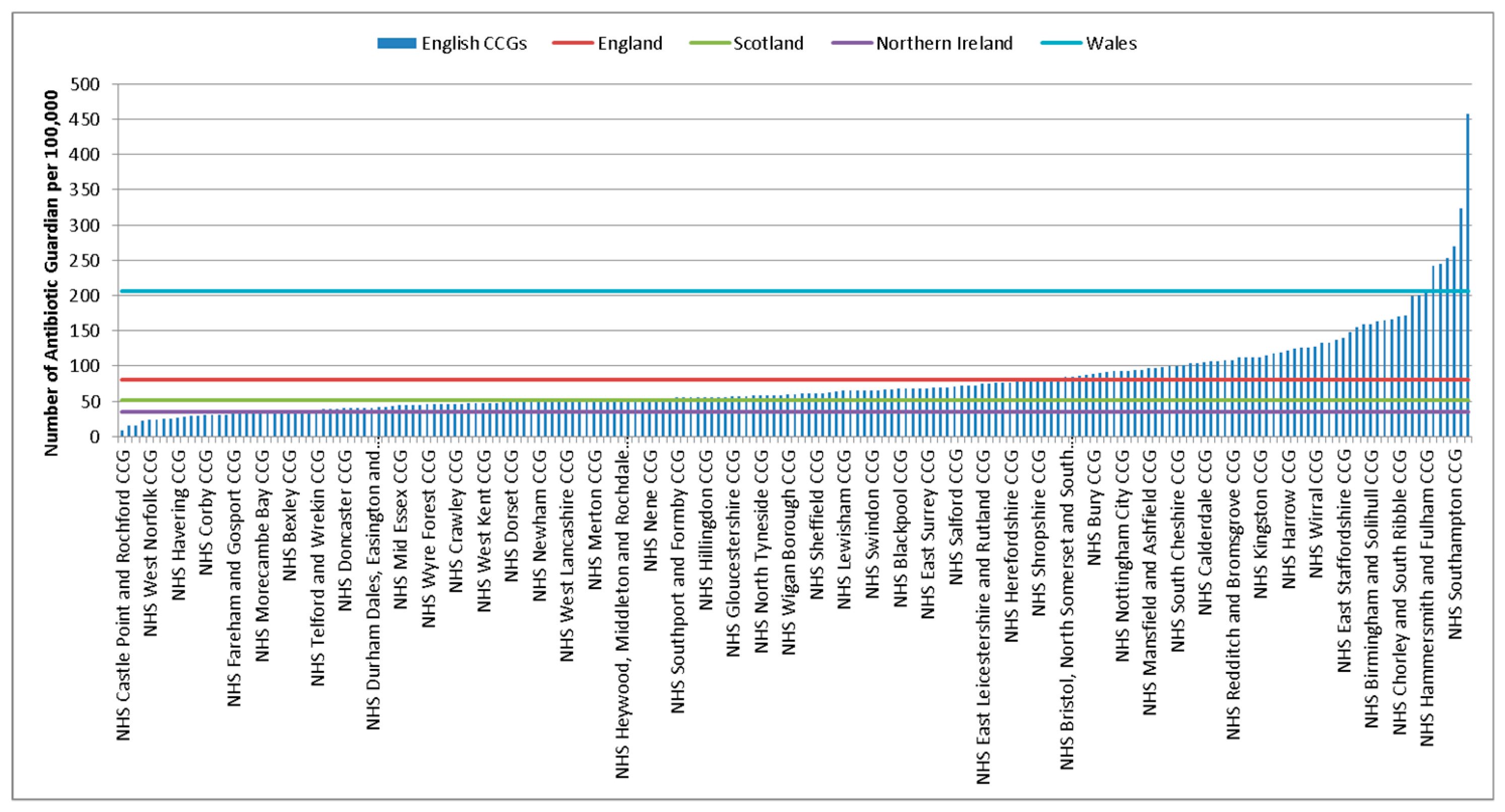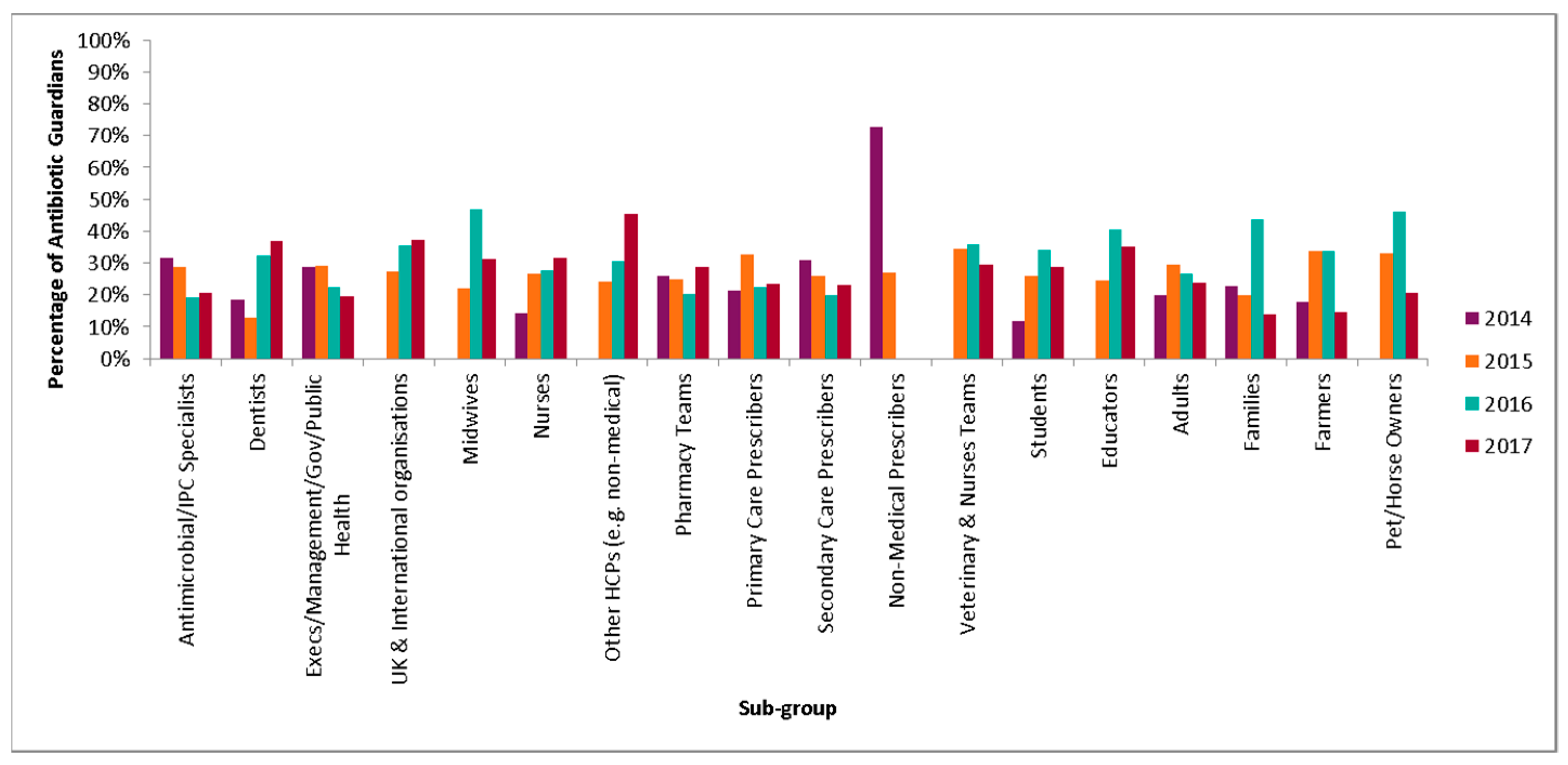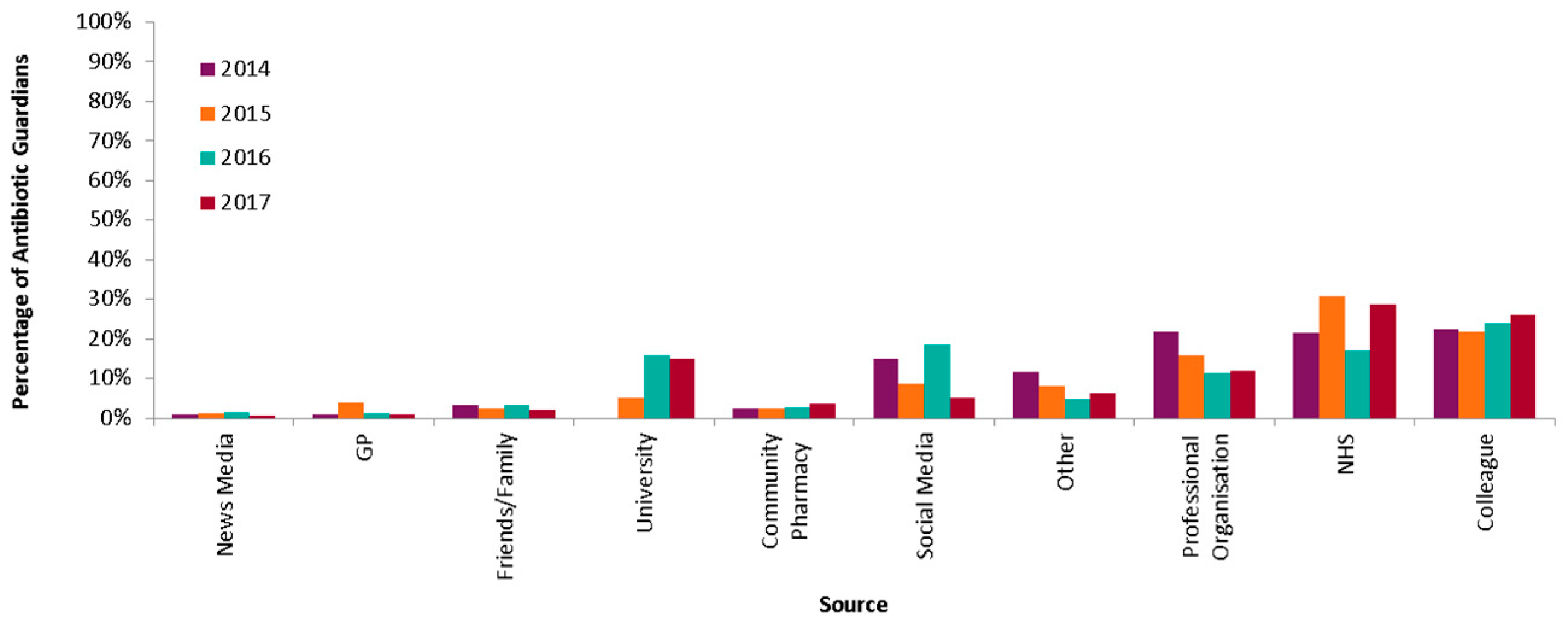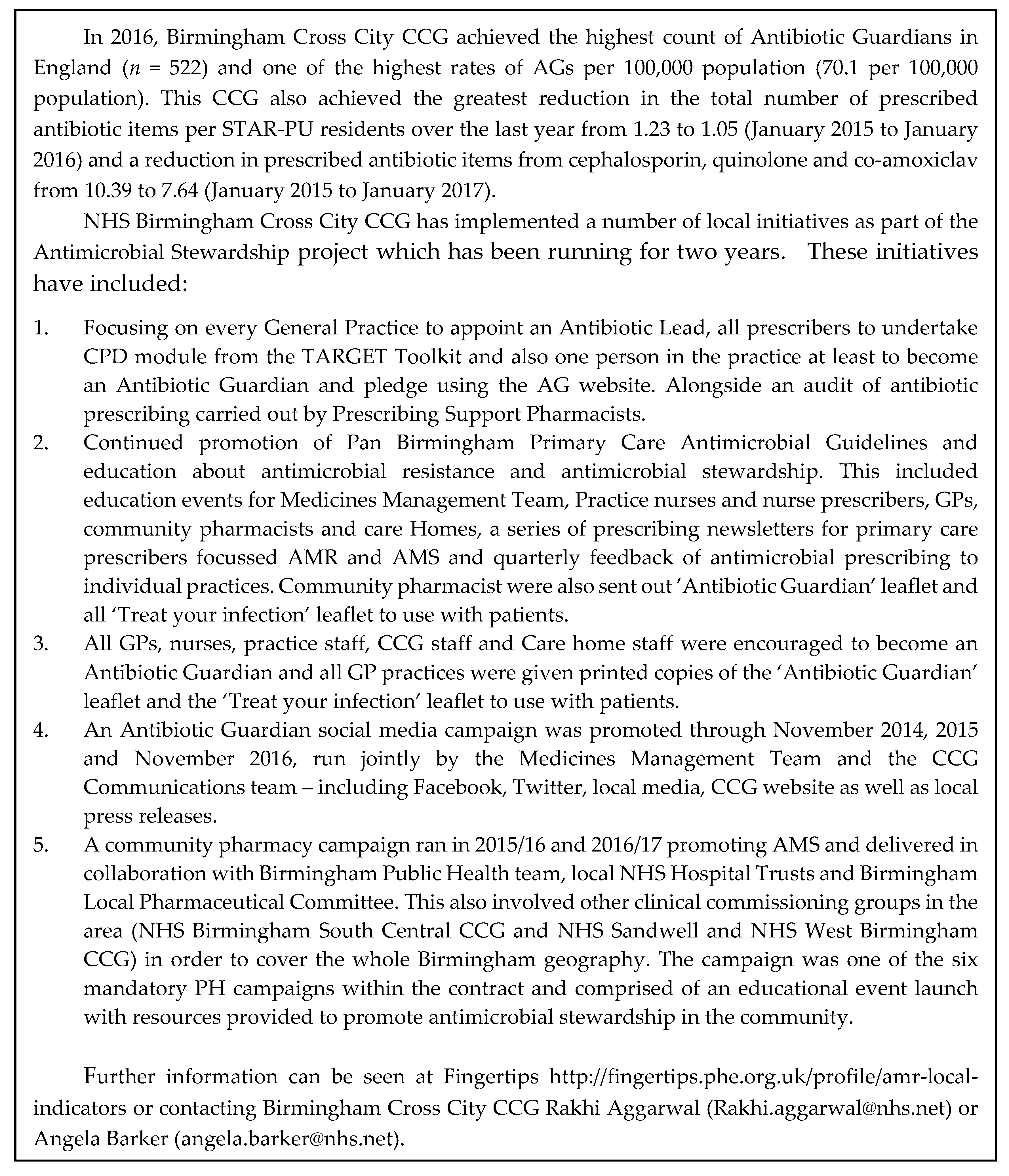2.1. Engagement
Since the start of the campaign, the website has been visited 291,431 times of which 79% were unique visitors (231,460). These visits have translated into 57,627 English language pledges, with an unadjusted conversion rate of 19.8% for the website as a whole. The number of visits to the site and pledges has increased each year (
Table 1). However, the conversion rate from 2014 has been relatively stable with the exception of a decline in 2016 to 15.6%. A similar decrease was also observed when the conversion rate was adjusted only to include new users. Translated website pages were available from November 2016 with 627 foreign language pledges and received the following conversion rates; Russian webpage 8.5%, Dutch webpage 19.3% and French webpage 8%.
The website received unique visits from 202 countries. The majority of these visits were from the UK (80.9%), but 19.1% of visits were from outside of the UK. The top five countries visiting the website outside of the UK were United States (n = 7391), Russia (n = 4675), Belgium (n = 3071), India (n = 1496) and Australia (n = 1420).
Overall, 44.6% of pledges were made from a unique IP address whereas 55.4% were from a repeated IP address. The median number of pledges made from a repeated IP address was 192 and ranged from 2–1647. The number of pledges from repeat IP addresses showed an increase from 64.2% in 2015 to 66.4% in 2017 (chi = 1200, p < 0.001). 8.7% (5019) of AGs had pledged more than once between 2014 and 2017.
For each year, there was a peak in the number of English pledges received during WAAW/EAAD which occur yearly in November (
Figure 1). A small peak in pledges was also noted in March 2016. However, the number of pledges during WAAW in 2017 (4682), decreased compared to 2016 (5120). The number of organisations in the UK who registered planned activities to be carried out during WAAW to raise awareness of antibiotic resistance in 2014 was 187, with a peak of 305 organisations in 2015 and 103 in 2016. In 2017, 149 organisations registered planned activities; leading to a 44.7% increase in registrations over the prior year.
Up to the end of 2017, where country was stated (n = 43,065) pledges had been received from 149 different countries therefore antibiotic guardians were present in 57.7% of countries worldwide; 95.9% (n = 41,309) from the UK, 1.4% (n = 618) from the rest of Europe and 2.6% (n = 1138) from the rest of the world. There was an increase in the number of countries with AGs from 63 countries in 2015 to 149 (Country map of AG—
Figure 2) in 2017 (137% increase). Country information was not collected during 2014.
The rate of AGs per 100,000 population in the UK between 2014–2017 was 83.3 (95% CI 82.6–84). There was some variation between UK countries with Wales having the highest rate at 206.6 per 100,000 population (95% CI 201.6–211.7), followed by England 81.1 (95% CI 80.3–81.9), Scotland 51.6 (95% CI 49.7–53.6) and Northern Ireland 35.2 (95% CI 32.6–38). A further breakdown by clinical commissioning groups (CCGs) and Health boards can be seen in
Figure 3 and
Table S1. Rates by local government authorities can be found in the
supplementary information (Table S2) which ranged from a rate of 9.1 (95% CI 5.2–14.8) per 100,000 population to 457.9 (95% CI 427.9–489.5) per 100,000 population.
The majority of unique visitors accessed the site through a desktop computer (58.8%) compared to a mobile device (e.g., phone or tablet) (41.2%). Individuals were also more likely to pledge to become an Antibiotic Guardian if accessing the site via a desktop computer compared to a mobile device, OR 1.26 (95% CI 1.23–1.28).
The most common acquisition route for unique visits to the site was self-directed, e.g., through a search engine or typing the website address directly into the browser which accounted for 55.2% of visits compared to 24.6% referred through social media, 15.3% referred through another website and 1.2% referred through links in emails. Other routes accounted for 3.7% of unique visits. Self-direction has remained the largest acquisition route across all four years. Compared to referrals via social media, individuals were more likely to pledge is they accessed the site through self-directed (OR 2.56, 95% CI 2.49–2.63) or via email referrals (OR 2.5, 95% CI 2.28–2.73) but showed no real difference of likelihood to pledge when referred through other websites (OR 0.99, 95% CI 0.96–1.04).
From 2014 to July 2016 there had been 136 publications, 108 bulletins/newsletters, 294 web articles and 40 international mentions of Antibiotic Guardian. The educational YouTube video entitled ‘Will you be an Antibiotic Guardian?’ accessible via the AG website and PHE YouTube channel was viewed 35,827 times with an average view time of 1.33 min out of 2.02 min (76% of the full video) and the ‘Antibiotic Resistance Playbuzz’ quiz launched on the website in November 2016 has been accessed 3900 times with 628 completions up until December 2016. Analysis of Twitter data over the first four years showed that #AntibioticGuardian had been tweeted 46,152 times by 15,307 people and 10,101 times during WAAW 2016. In 2017 WAAW 2333 individuals participated in Twitter’s social media with 5737 tweets posting the #AntibioticGuardian hashtag.
2.2. Audience
The most common pledge group overall was health care professionals (54.3%) (
Table 2), which has remained the highest through the four years. Within this group, the most common pledge groups are pharmacy teams (34%), nurses (20.8%) and primary/secondary prescribers (16.8%) (
Figure 4). The proportion of AGs who were nurses increased from 7.4% (n = 908) in 2014 to 13.4% (n = 2030) in 2017. Dentists also increased from 1.7% (n = 215) to 2.8% (n = 428). The most common pledge chosen by health professionals was ‘I will check that antibiotic prescriptions comply with the local guidance and query those that do not’. This accounted for 13.4% of pledges (n = 4155) and was one of the pharmacy pledges. A further breakdown of the most common pledge for each sub group of the three main pledge groups is shown in
Table 3.
There was a significant increase in the proportion of AG that are in student and educator pledge category from 8.8% in 2014 to 19.4% in 2017 (chi = 947.13,
p < 0.001). The highest proportion of students pledging were pharmacy students (
Table 4. The most common pledge choice for students was ‘the next time I see an antibiotic prescribed, I will ask the prescriber about the indication and duration, to understand if this is in accordance to local and national guidelines’ which accounted for 19.2% of pledges (n = 1767). This was the most common pledge chosen by healthcare students and non-healthcare students.
There was a reduction in the proportion of pledgers who are members of the public (28% in 2014 vs. 23.8% in 2017) which was significant (chi = 277.4, p < 0.001), the majority of which were adults (79.7%). The most common pledge chosen by the public was ‘for infections that our bodies are good at fighting off on their own, like coughs, colds, sore throats and flu, I pledge to try treating the symptoms for five days rather than going to the GP’. This was an adult sub group pledge and accounted for 32.3% of pledges (n = 5211). Where gender could be inferred (n = 51,149), the majority of AGs were female (73%).
2.3. AMR Knowledge
In total 3289 AGs answered 16,445 questions on AMR knowledge (5 questions each); 94.4% (n = 15,521) were answered correctly and 80% of AGs answered all five questions correctly. For individual questions, the percentage answered correctly ranged from 91.1% for ‘taking antibiotics often has side effects such as diarrhoea’ to 98% for ‘unnecessary use of antibiotics makes them become ineffective’ (
Table 5).
There was some variation between pledge groups for the percentage of questions answered correctly as shown in
Table 5. The HCP answered significantly more questions correctly (96.5%, n = 8677/8995) compared to students (92.8%, n = 3375/3635) (chi 154.64,
p < 0.001) and the public (91.2%, n = 3469/3805) (chi = 77.57,
p < 0.001).
The Eurobarometer survey on Antimicrobial resistance used questions 1 to 4 to survey the EU general population and publish results on AMR knowledge by country. For each of these questions, all AG groups (including the public) answered a higher proportion of these correctly when compared to the UK and EU published figures (
Table 5). AGs were more likely to answer all four questions correctly than the UK group (OR 8.5, 95% CI 7.4–9.9) and the EU group (OR 13.9, 95% CI 12.7–15.3). AGs answered an average of 3.8 questions correctly compared to 2.8 for UK and 2.5 for EU.
2.4. Source
Where indicated (n = 46,798), AGs (HCPs, students and public combined) most commonly heard about the campaign from colleagues (23.9%), within the NHS (23.3%) or from professional organisations (14.8%) (
Figure 5). These sources remained the most common sources all through 2014 to 2017. However, increases were noted in hearing through the university (2015 and 2016) and social media (2016).
The source varied by group with the public mainly hearing about the campaign by NHS (31.1%) and the social media (20.9%), HCPs through colleagues (33.2%) and professional organisations (20.5%), whereas students heard from the university (47.6%). The public was more likely to hear about the campaign from social media than the health care professionals (OR 3.10, 95% CI 2.91–3.31) and students (OR 1.94, 95% CI 1.36–1.61).
2.5. Antibiotic Guardian Campaign—Assessment of Self Reported Knowledge and Behaviour Change
Overall, 1940 AGs (6.8% response rate) completed the online survey which self-reported behaviours following their pledges (outcomes). Of those with gender recorded, the majority (76.8%) were females and about half (56%) of the respondents pledged as health professionals with 30.8% (598) pledging as a member of the public. Of those respondents, where the year of the pledge was indicated (n = 1031), almost all (95.1%) had pledged within the previous 16 months of the survey. Characteristic of AGs that participated in the survey is shown in
Table 6.
Prior to hearing about the AG campaign, 86% of respondents were aware of antibiotic resistance, 32.2% (537) of this group stated that they believed that antibiotic resistance is an important issue they can do something about as individuals. Where indicated (n = 1696), 28.1% believed Antibiotic Guardian website was an important source that impacted their knowledge on antibiotic resistance.
In selecting a pledge, 47.5% of respondents (922) chose a specific pledge because of their belief in successfully delivering on their commitment, of which 64.3% (593) were healthcare professionals. Of this group (n = 922), 60.6% self-reported to ‘always’ act in line with their pledge and 31.8% acted ‘most of the time.’ Overall, 61.8% of AGs ‘always’ acted in line with their pledge after the campaign. A higher proportion of AGs who were members of the public (84.9%), reported ‘always’ acting in line with their pledge compared to healthcare professionals (49.6%), with an odds ratio of 5.7 (95% CI 4.4–7.4, p < 0.001).
For members of the public, ‘I know that antibiotic resistance is a very important problem for public health’ (64.6%) was the most common reason for pledging to become an Antibiotic Guardian, while professional experience with antibiotic resistance (37.6%) was the most commonly stated reason for healthcare professionals.
